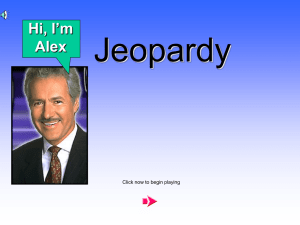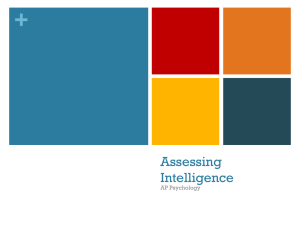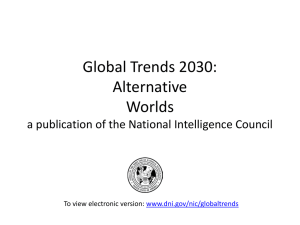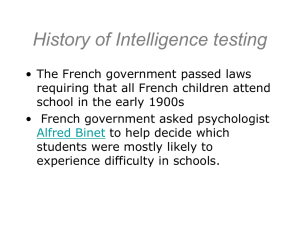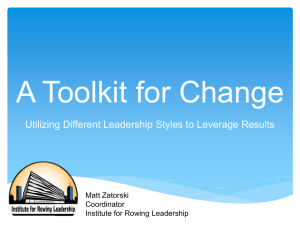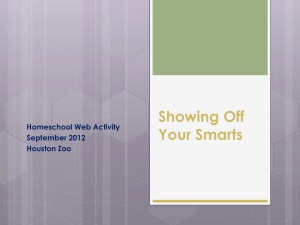Intelligence
advertisement
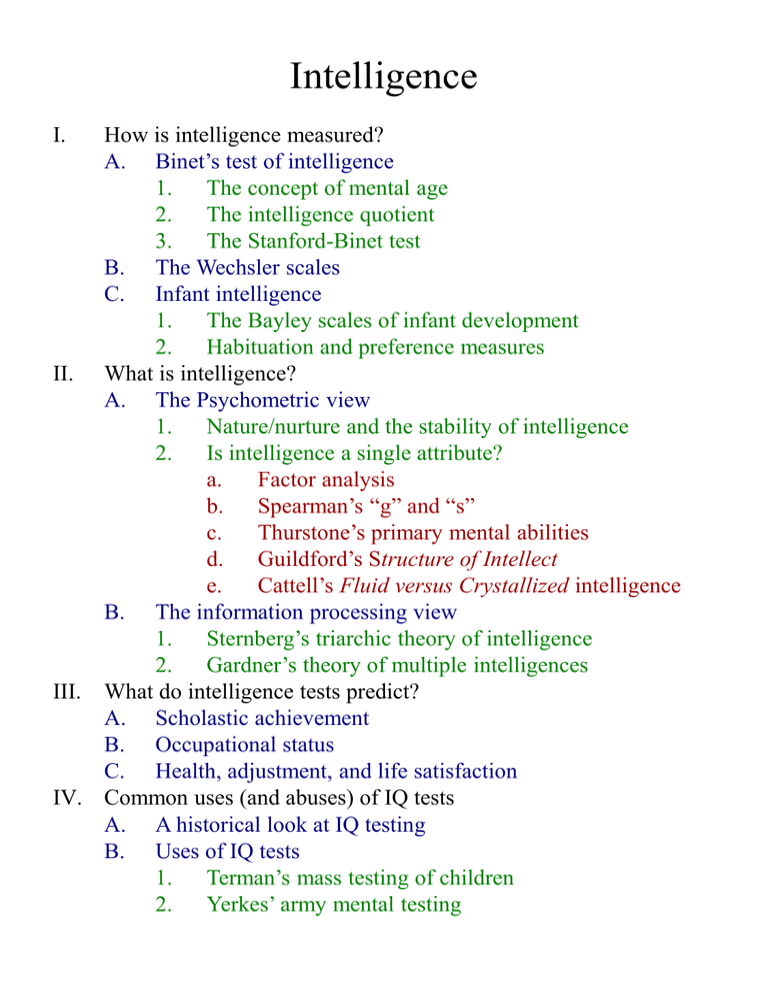
Intelligence I. How is intelligence measured? A. Binet’s test of intelligence 1. The concept of mental age 2. The intelligence quotient 3. The Stanford-Binet test B. The Wechsler scales C. Infant intelligence 1. The Bayley scales of infant development 2. Habituation and preference measures II. What is intelligence? A. The Psychometric view 1. Nature/nurture and the stability of intelligence 2. Is intelligence a single attribute? a. Factor analysis b. Spearman’s “g” and “s” c. Thurstone’s primary mental abilities d. Guildford’s Structure of Intellect e. Cattell’s Fluid versus Crystallized intelligence B. The information processing view 1. Sternberg’s triarchic theory of intelligence 2. Gardner’s theory of multiple intelligences III. What do intelligence tests predict? A. Scholastic achievement B. Occupational status C. Health, adjustment, and life satisfaction IV. Common uses (and abuses) of IQ tests A. A historical look at IQ testing B. Uses of IQ tests 1. Terman’s mass testing of children 2. Yerkes’ army mental testing Measures of Intelligence The Stanford-Binet test Alfred Binet The Stanford-Binet test • Mental age and chronological age • The Intelligence Quotient (IQ) Measures of Intelligence The Wechsler Scales David Wechsler The WISC-IV (Wechsler Intelligence Scale for Children) – 6 to 16 yrs The WPPSI-III (Wechsler Preschool and Primary Scale of Intelligence-Revised) – 2 to 7 yrs Measures of Intelligence Infant Intelligence Nancy Bayley The Bayley Scales of Infant Development (BSID-III) • Cognitive, Language, Motor • Socio-Emotional, Adaptive Behavior • The Developmental Quotient (DQ) Habituation and Preferential looking measures • Speed of habituation • Preference for novelty The Psychometric View of Intelligence Intelligence can be thought of as a trait, or set of traits, that characterize some people to a greater extent than other people Four different psychometric view 1. The ability to carry out abstract thinking (Terman, 1921) 2. The capacity of an individual to act purposefully and think rationally, and to deal effectively with the environment (Wechsler, 1944) 3. Innate, general cognitive ability (Burt, 1955) 4. All of the knowledge a person has acquired (Robinson & Robinson, 1965) Factor Analysis Test Items: 1 2 3 4 5 6 7 8 9 10 Highly correlated test items: • • • 1, 3, 4, 8 2, 5, 9, 10 6, 7 Factor Structure: • • • Questions related to verbal ability Questions related to mathematical reasoning Questions related to spatial abilities Structure of Intellect Model Guildford’s (1967) J. P. Guilford Content: What a person thinks about Operations: The kinds of thinking required Products: The kinds of answers required Fluid versus Crystallized Intelligence (Cattell, 1971, 1984) Raymond Cattell Fluid intelligence: • The ability to solve abstract relational problems that have not been explicitly taught and are free of cultural influences • Ex., Verbal analogies, memory for lists, etc. Crystallized intelligence: • The ability to solve problems that depend on knowledge acquired in school or through other experiences • Ex., General information, word comprehension Developmental flavor Triarchic Theory of Intelligence Sternberg (2001, 2005, 2008) Robert Sternberg • Analytic intelligence • Information processing components that underlie all intelligent acts • Strategies, self-regulation, metacognitive knowledge • Creative intelligence • The ability to generate solutions to new problems • The automatization of tasks to free working memory • Practical intelligence • Adapting to, shaping, or selecting the environment • Fit one’s desires to the demands of the environment Theory of Multiple Intelligences Gardner (1983, 1993) Howard Gardner • No general intelligence • 8 (or 9 according to some) intelligences • Each has a unique biological basis, course of development, and end-state • Problems with theory • Neurological evidence • Several dimensions have features in common What Do Intelligence Tests Predict? IQ and scholastic achievement • IQ predicts academic achievement • Caveats IQ and occupational success • IQ and job prestige • IQ and job performance IQ and health, adjustment, and life satisfaction • Terman’s longitudinal study with school children • Family environment hypothesis Binet’s Principles for the Use of the Intelligence Measure 1. The scores are a practical device; they do not support any theory of intellect. They do not define anything innate or permanent. We do not designate what they measure as “intelligence.” 2. The scale is a rough, empirical guide for identifying mild-retarded and learning disabled children who need special help. It is not a device for ranking normal children. 3. Whatever the cause of difficulty in children identified for help, emphasis shall be placed on improvement through special training. Low scores shall not be used to mark children as innately incapable Gould, 1981, p. 155
